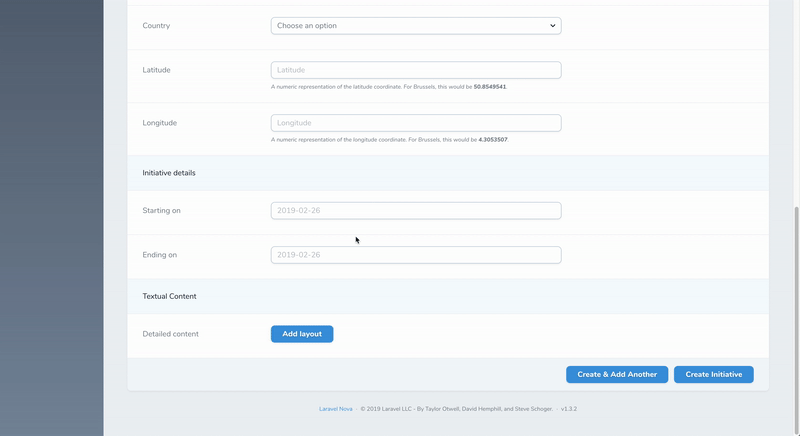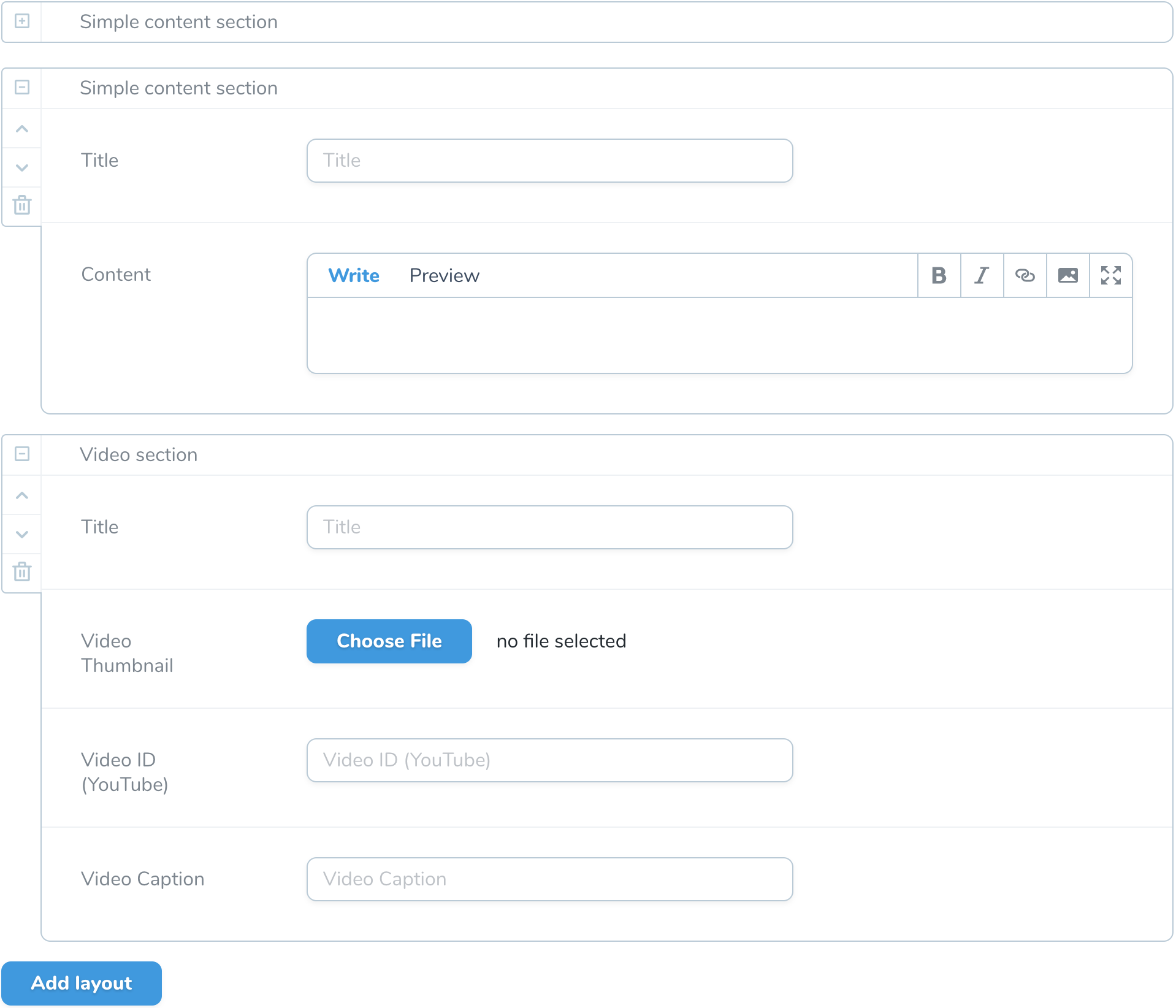An easy & complete Flexible Field for Laravel Nova, perfect for repeated and flexible field groups.
The Flexible field can be used in various ways and for different purposes, but in most cases you'll only need a few of its capabilities. Here's how to get started really quickly.
composer require whitecube/nova-flexible-content
A flexible field allows easy management of repeatable and orderable groups of fields. As opposed to the few existing solutions for Laravel Nova, this one does not have constraints on which fields you are allowed to use within these groups. That means you can use all Laravel Nova field types, and also any community-made fields.
A layout represents a group of fields that can be repeated inside the Flexible field. You can add as many different layouts as you wish. If only one layout is defined the field will behave like a simple Repeater and by adding more layouts you'll obtain a Flexible Content. Both concepts are similar to their cousins in Wordpress' ACF Plugin.
Layouts can be added using the following method on your Flexible fields:
addLayout(string $title, string $name, array $fields)The $name parameter is used to store the chosen layout in the field's value. Choose it wisely, you'll probably use it to identify the layouts in your application.
use Whitecube\NovaFlexibleContent\Flexible;
/**
* Get the fields displayed by the resource.
*
* @param \Illuminate\Http\Request $request
* @return array
*/
public function fields(Request $request)
{
return [
// ...
Flexible::make('Content')
->addLayout('Simple content section', 'wysiwyg', [
Text::make('Title'),
Markdown::make('Content')
])
->addLayout('Video section', 'video', [
Text::make('Title'),
Image::make('Video Thumbnail', 'thumbnail'),
Text::make('Video ID (YouTube)', 'video'),
Text::make('Video Caption', 'caption')
])
];
}You can change the default "Add layout" button's text like so:
Flexible::make('Content')
->button('Add something amazing!');You can make the flexible field full width, taking up all available space on the form, and moving the label above the field by doing the following:
Flexible::make('Content')
->fullWidth()You can limit how many times the "Add Layout" button will appear by doing the following:
Flexible::make('Content')->limit(2);You can specify any integer, or no integer at all; in that case it will default to 1.
You can choose to display a confirmation prompt before a layout is deleted by doing:
Flexible::make('Content')->confirmRemove();
// You can override the text as well
Flexible::make('Content')->confirmRemove($label = '', $yes = 'Delete', $no = 'Cancel');You can customize the way your user selects a layout, you can choose between 'flexible-drop-menu' and 'flexible-search-menu' or create your own custom menu component.
// Default, simple list of all layouts
Flexible::make('Content')->menu('flexible-drop-menu');
// searchable select field
Flexible::make('Content')->menu('flexible-search-menu');
// customized searchable select field
Flexible::make('Content')
->menu(
'flexible-search-menu',
[
'selectLabel' => 'Press enter to select',
// the property on the layout entry
'label' => 'title',
// 'top', 'bottom', 'auto'
'openDirection' => 'bottom',
]
);All you're doing here is defining which Vue component needs to be used.
You can take resources/js/components/OriginalDropMenu.vue or resources/js/components/SearchMenu.vue as a starting point.
The field stores its values as a single JSON string, meaning this string needs to be parsed before it can be used in your application.
This can be done trivially by using the FlexibleCast class in this package:
namespace App;
use Illuminate\Database\Eloquent\Model;
use Whitecube\NovaFlexibleContent\Value\FlexibleCast;
class MyModel extends Model
{
protected $casts = [
'flexible-content' => FlexibleCast::class
];
}By default, the FlexibleCast class will collect basic Layout instances. If you want to map the layouts into Custom Layout instances, it is also possible. First, create a custom flexible cast by running php artisan flexible:cast MyFlexibleCast. This will create the file in the App\Casts directory.
Then easily map your custom layout classes to the proper keys:
namespace App\Casts;
class MyFlexibleCast extends FlexibleCast
{
protected $layouts = [
'wysiwyg' => \App\Nova\Flexible\Layouts\WysiwygLayout::class,
'video' => \App\Nova\Flexible\Layouts\VideoLayout::class,
];
}If you need to do complex things with your mappings instead of having a static array as shown above, you can override the getLayoutMappings method on your cast.
namespace App\Casts;
class MyFlexibleCast extends FlexibleCast
{
protected function getLayoutMappings()
{
$mappings = [];
// Conditionally add mappings however you want
return $mappings;
}
}By implementing the HasFlexible trait on your models, you can call the flexible($attribute) method, which will automatically transform the attribute's value into a fully parsed Whitecube\NovaFlexibleContent\Layouts\Collection. Feel free to apply this flexible() call directly in your blade views or to extract it into an attribute's mutator method as shown below:
namespace App;
use Illuminate\Database\Eloquent\Model;
use Whitecube\NovaFlexibleContent\Concerns\HasFlexible;
class MyModel extends Model
{
use HasFlexible;
public function getFlexibleContentAttribute()
{
return $this->flexible('flexible-content');
}
}By default, the HasFlexible trait will collect basic Layout instances. If you want to map the layouts into Custom Layout instances, it is also possible to specify the mapping rules as follows:
public function getFlexibleContentAttribute()
{
return $this->flexible('flexible-content', [
'wysiwyg' => \App\Nova\Flexible\Layouts\WysiwygLayout::class,
'video' => \App\Nova\Flexible\Layouts\VideoLayout::class,
]);
}Collections returned by FlexibleCast or the HasFlexible trait extend the original Illuminate\Support\Collection. These custom layout collections expose a find(string $name) method which returns the first layout having the given layout $name.
Layouts are some kind of fake models. They use Laravel's HasAttributes trait, which means you can define accessors & mutators for the layout's attributes.
Each Layout (or custom layout extending the base Layout) already implements the HasFlexible trait, meaning you can directly use the $layout->flexible('my-sub-layout') method to parse nested flexible content values.
Furthermore, it's also possible to access the Layout's properties using the following methods:
Returns the layout's name.
Returns the layout's title (as shown in Nova).
Returns the layout's unique key (the layout's unique identifier).
When using the Flexible Content field, you'll quickly come across of some use cases where the basics described above are not enough. That's why we developed the package in an extendable way, making it possible to easily add custom behaviors and/or capabilities to Field and its output.
Sometimes, addLayout definitions can get quite long, or maybe you want them to be shared with other Flexible fields. The answer to this is to extract your Layout into its own class.
namespace App\Nova\Flexible\Layouts;
use Laravel\Nova\Fields\Text;
use Laravel\Nova\Fields\Markdown;
use Whitecube\NovaFlexibleContent\Layouts\Layout;
class SimpleWysiwygLayout extends Layout
{
/**
* The layout's unique identifier
*
* @var string
*/
protected $name = 'wysiwyg';
/**
* The displayed title
*
* @var string
*/
protected $title = 'Simple content section';
/**
* Get the fields displayed by the layout.
*
* @return array
*/
public function fields()
{
return [
Text::make('Title'),
Markdown::make('Content')
];
}
}You can then refer to this class as first and single parameter of the addLayout(string $classname) method:
Flexible::make('Content')
->addLayout(\App\Nova\Flexible\Layouts\SimpleWysiwygLayout::class);You can limit how many times the "Add Layout" button will appear for a specific type in a custom Layout class by setting the $limit attribute.
/**
* The maximum amount of this layout type that can be added
*/
protected $limit = 1;You can specify any integer, or no integer at all; in that case it will default to 1.
You can create these Layout classes easily with the following artisan command
php artisan flexible:layout {classname?} {name?}
// Ex: php artisan flexible:layout SimpleWysiwygLayout wysiwyg
In addition to reusable Layout classes, you can go a step further and create Preset classes for your Flexible fields. These allow you to reuse your whole Flexible field anywhere you want. They also make it easier to make your Flexible fields dynamic, for example if you want to add Layouts conditionally. And last but not least, they also have the added benefit of cleaning up your Nova Resource classes, if your Flexible field has a lot of addLayout definitions.
namespace App\Nova\Flexible\Presets;
use App\PageBlocks;
use Whitecube\NovaFlexibleContent\Flexible;
use Whitecube\NovaFlexibleContent\Layouts\Preset;
class WysiwygPagePreset extends Preset
{
/**
* The available blocks
*
* @var Illuminate\Support\Collection
*/
protected $blocks;
/**
* Create a new preset instance
*
* @return void
*/
public function __construct()
{
$this->blocks = PageBlocks::orderBy('label')->get();
}
/**
* Execute the preset configuration
*
* @return void
*/
public function handle(Flexible $field)
{
$field->button('Add new block');
$field->resolver(\App\Nova\Flexible\Resolvers\WysiwygPageResolver::class);
$field->help('Go to the "<strong>Page blocks</strong>" Resource in order to add new WYSIWYG block types.');
$this->blocks->each(function($block) use ($field) {
$field->addLayout($block->title, $block->id, $block->getLayoutFields());
});
}
}Please note that Preset classes are resolved using Laravel's Container, meaning you can type-hint any useful dependency in the Preset's __construct() method.
Once the Preset is defined, just reference its classname in your Flexible field using the preset method:
Flexible::make('Content')
->preset(\App\Nova\Flexible\Presets\WysiwygPagePreset::class);You can create these Preset classes easily with the following artisan command:
php artisan flexible:preset {classname?}
// Ex: php artisan flexible:preset WysiwygPagePreset
By default, the field takes advantage of a JSON column on your model's table. In some cases, a JSON attribute is just not the way to go. For example, you could want to store the values in another table (meaning you'll be using the Flexible Content field instead of a traditional BelongsToMany or HasMany field). No worries, we've got you covered!
First, create the new Resolver class. For convenience, this can be achieved using the following artisan command:
php artisan flexible:resolver {classname?}
// Ex: php artisan flexible:resolver WysiwygPageResolver
It will place the new Resolver class in your project's app/Nova/Flexible/Resolvers directory. Each Resolver should implement the Whitecube\NovaFlexibleContent\Value\ResolverInterface contract and therefore feature at least two methods: set and get.
The get method is used to resolve the field's content. It is responsible to retrieve the content from somewhere and return a collection of hydrated Layouts. For example, we could want to retrieve the values on a blocks table and transform them into Layout instance:
/**
* get the field's value
*
* @param mixed $resource
* @param string $attribute
* @param Whitecube\NovaFlexibleContent\Layouts\Collection $layouts
* @return Illuminate\Support\Collection
*/
public function get($resource, $attribute, $layouts) {
$blocks = $resource->blocks()->orderBy('order')->get();
return $blocks->map(function($block) use ($layouts) {
$layout = $layouts->find($block->name);
if(!$layout) return;
return $layout->duplicateAndHydrate($block->id, ['value' => $block->value]);
})->filter();
}The set method is responsible for saving the Flexible's content somewhere the get method will be able to access it. In our example, it should store the data in a blocks table:
/**
* Set the field's value
*
* @param mixed $model
* @param string $attribute
* @param Illuminate\Support\Collection $groups
* @return void
*/
public function set($model, $attribute, $groups)
{
$class = get_class($model);
$class::saved(function ($model) use ($groups) {
$blocks = $groups->map(function($group, $index) {
return [
'name' => $group->name(),
'value' => json_encode($group->getAttributes()),
'order' => $index
];
});
// This is a quick & dirty example, syncing the models is probably a better idea.
$model->blocks()->delete();
$model->blocks()->createMany($blocks);
});
}By popular demand, we have added compatibility with the advanced-nova-media-library field. This requires a few extra steps, as follows:
- You must use a custom layout class.
- Your custom layout class must implement
Spatie\MediaLibrary\HasMediaand use theWhitecube\NovaFlexibleContent\Concerns\HasMediaLibrarytrait. - The parent model must implement
Spatie\MediaLibrary\HasMediaand use theSpatie\MediaLibrary\InteractsWithMediatrait.
Quick example, consider Post has a flexible field with a SliderLayout:
use Spatie\MediaLibrary\HasMedia;
use Illuminate\Database\Eloquent\Model;
use Spatie\MediaLibrary\InteractsWithMedia;
use Whitecube\NovaFlexibleContent\Concerns\HasFlexible;
class Post extends Model implements HasMedia
{
use HasFlexible;
use InteractsWithMedia;
}use Spatie\MediaLibrary\HasMedia;
use Whitecube\NovaFlexibleContent\Layouts\Layout;
use Ebess\AdvancedNovaMediaLibrary\Fields\Images;
use Whitecube\NovaFlexibleContent\Concerns\HasMediaLibrary;
class SliderLayout extends Layout implements HasMedia
{
use HasMediaLibrary;
protected $name = 'sliderlayout';
protected $title = 'SliderLayout';
public function fields()
{
return [
Images::make('Images', 'images')
];
}
}You can now call getMedia('images') on your SliderLayout instance.
Feel free to suggest changes, ask for new features or fix bugs yourself. We're sure there are still a lot of improvements that could be made and we would be very happy to merge useful pull requests.
Thanks!
When adding a new feature or fixing a bug, please add corresponding unit tests. The current set of tests is limited, but every unit test added will improve the quality of the package.
Run PHPUnit by calling composer test.
At Whitecube we use a lot of open source software as part of our daily work. So when we have an opportunity to give something back, we're super excited! We hope you will enjoy this small contribution from us and would love to hear from you if you find it useful in your projects.




